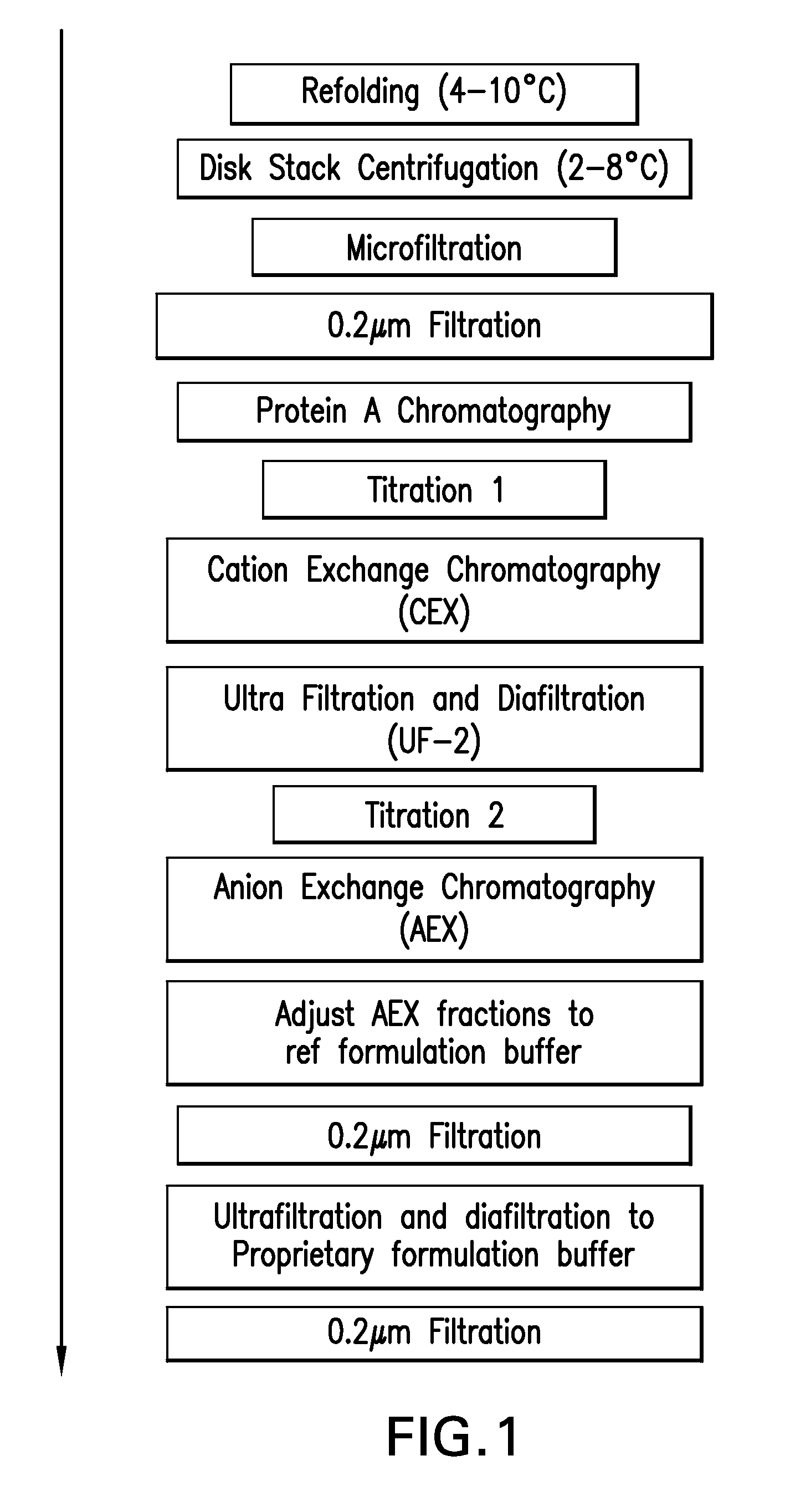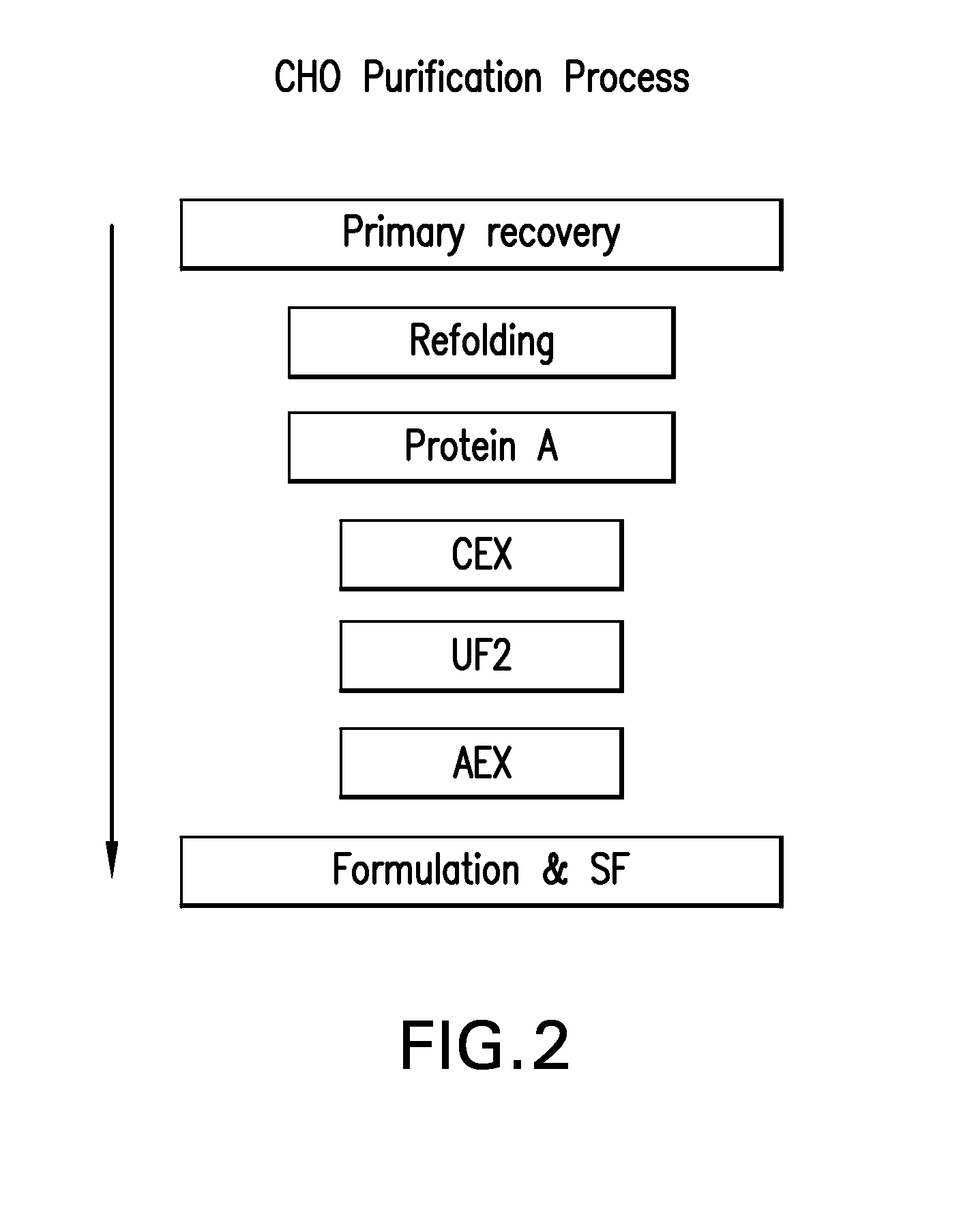Purification of fusion proteins
- Summary
- Abstract
- Description
- Claims
- Application Information
AI Technical Summary
Benefits of technology
Problems solved by technology
Method used
Image
Examples
example 1
Optimization of Chromatography Unit Operations
Methods and Materials
[0182]Centrate collected from Pichia culture fermentation broths containing human TNFR:Fc fusion protein was further clarified by microfiltration an sterile filtered. Filtrate was stored at 4° C. and used as feed for all experiments.
[0183]All of the chromatography steps were performed on columns at lab scale using AKTA explorer equipped with UNICORN software. Centrate was fed onto the columns which were subsequently washed. Protein A resin with bound product was subsequently resuspended and the resulting slurry dispensed into the wells of a 96-well filter plate. High throughput methods using GENESIS software on TECAN equipment equipped with a liquid handling arm, a robotic manipulation arm, vacuum filtration, magnetic stirrer and microplate reader with MAGELLAN software were employed to evaluate alternative wash / elution conditions.
[0184]Intact, aggregated and misfolded product was detected using analytical HIC butyl ...
example 2
Purification of Recombinant Human TNFR:Fc from Glycoengineered Pichia Pastoris Fermentation
[0200]The primary objectives of this experiment was to demonstrate scale-up of a purification process comprising the above-described unit operations which were optimized using small scale purification experiments and high-throughput screening methods.
[0201]In practice, the objectives of Protein A chromatography are enrichment of Total Sialic Acid (TSA), and decrease in aggregates and misfolds in the product. Objectives for the intermediate CEX chromatography step include retaining POI with high TSA levels, while clearing Host Cell Protein (HCP), DNA and leached Protein A ligand. The AEX polishing chromatography step is used to further enrich TSA levels and remove remaining process residuals.
Methods and Materials
[0202]Protein A resin—Poros MabCapture A run in bind and elute mode.
Cation exchange resin—POROS HS strong cation exchange adsorbent run in bind and elute mode.
Anion exchange resin—POROS...
example 3
Purification of TNFR:Fc from Cho Cell Culture Supernatant (CCS)
Materials and Methods:
[0228]The CCS used in the experiment, described herein, was produced using two different CHO cell lines (23D8 and 18G10). TNFR:Fc was purified from each culture separately, according to the downstream process flow scheme as outlined in FIG. 2. Briefly the downstream process involves a Protein A primary recovery step, a CEX intermediate purification step, at least one ultrafiltration step, an AEX polishing step, and a final formulation step.
A. Primary Recovery and Refolding
[0229]The CCS was refolded to convert misfolded and aggregated species to correctly folded monomer. The refolding conditions used were those developed for Pichia-expressed TNFR:Fc in which the broth was cooled to <10° C., cysteine added for a final concentration of 5 mM, and pH adjusted to 8.6 using 1.0M Trizmabase plus 0.5M arginine. The refolding and titration were done at <10° C., to minimize the effect of temperature on pH. The...
PUM
| Property | Measurement | Unit |
|---|---|---|
| Fraction | aaaaa | aaaaa |
| Molar density | aaaaa | aaaaa |
| Molar density | aaaaa | aaaaa |
Abstract
Description
Claims
Application Information
 Login to View More
Login to View More - R&D
- Intellectual Property
- Life Sciences
- Materials
- Tech Scout
- Unparalleled Data Quality
- Higher Quality Content
- 60% Fewer Hallucinations
Browse by: Latest US Patents, China's latest patents, Technical Efficacy Thesaurus, Application Domain, Technology Topic, Popular Technical Reports.
© 2025 PatSnap. All rights reserved.Legal|Privacy policy|Modern Slavery Act Transparency Statement|Sitemap|About US| Contact US: help@patsnap.com



